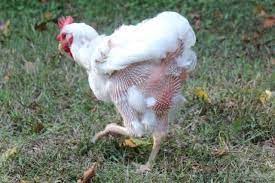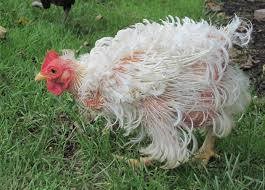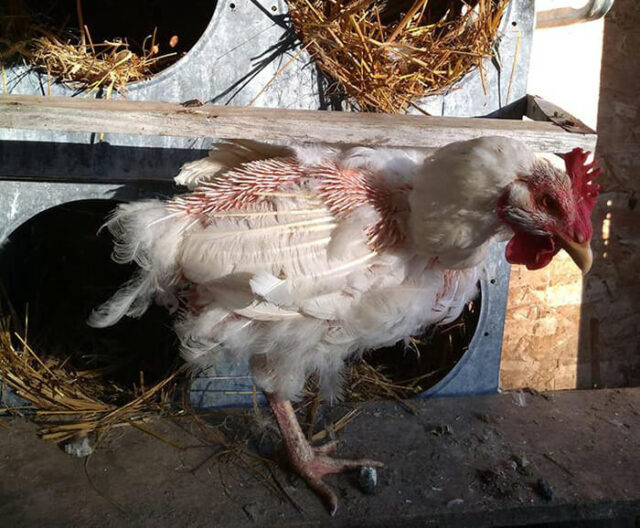Moulting is defined as a normal physiological process of shedding and renewing feathers in feathered species which occurs in both males and females in the wild state birds usually shed and renew old, worn plumage before the beginning of the cold weather. This process of shedding feathers is controlled by gonads and the thyroid gland which is associated with a drop in estrogen levels and decreasing rate of egg production it occurs once a year in natural circumstances. Natural moulting in commercial layers occurs normally after 8 to 12 months of egg production. Loss of feathers in birds is an orderly process beginning with the shedding of feathers from the head followed by feathers on the neck, body, wing, and at last tail. Onset and length are affected by several factors such as Weight and physical condition of the bird, Length of light exposure, Nutrition of the bird, and Environmental temperature and humidity. The moulting process can be fastened through a program of induced moulting, thereby recycling the hens for another period of egg production and improving egg quality.


Purpose of Induced Moulting (Flock Recycling)
It helps to decrease the cost to bring the flock into production. It causes an increase in the length of egg production. It is helpful when the current egg prices are low in anticipation of higher egg prices after the flock returns to production. Moulting can be performed when there is the availability of empty laying houses.
Induced Moulting Requirements
During induced moulting a layer flock is induced to shed and replace its feathers at a time selected by the flock manager. An induced moult causes all of the hens in a flock to go out of production for a period of time. During this period, regressing and rejuvenation of the reproductive tract occur, accompanied by the loss and replacement of feathers.
Induced Molting Involves Three Main Factors:
- Initiating the Moult-All moulting programs require that egg production be reduced to zero, which is usually accomplished by fasting (no feed) the flock or by limiting critical nutrients such as protein, calcium or sodium until or beyond the time of production ceases. Artificial lights should be turned off in open-sided houses and reduced to not more than 8 hours in environmentally controlled houses.
- Resting the Flock-Once the flock is out of production, it may be held out of production for as little as 1 week to as much as 4 to 5 weeks depending on the requirement and the feeding program implemented during this period. The level of nutrition can regulate the length of the resting period. Low-protein or low-calcium diets will generally keep a flock out of production.
- Returning the Flock to Production-When the flock is to be returned to production, a layer diet should be fed and lights should be returned to the normal lighting program for layers. A 50% rate of lay should be reached in 2 to 3 weeks and the peak should follow in an additional 2 to 4 weeks.

Types of induced moulting programme
- Two cycles moulting program-This program involves one moult and two egg production cycles. The hens are moulted after about 10 months of egg production, brought back into egg production and then sold at about 24 months of age.
- Multiple-cycle moulting program-This program involves two or more moults and three or more cycles of egg production. The hens are first moulted after about 9 months of production, then held through successfully shorter cycles and sold at 30 or more months of age.
Method of induced moulting
- Low nutrient diet program
- Moulting by feeding zinc
- Use of drugs and other compounds
Many countries do not allow egg producers to use the fasting methods because of concern for the welfare of the flocks. In such instances, the producer must use feeding programs that will achieve zero egg production without resorting to the complete removal of feed. These methods include
- Full or limited feeding of low protein or low nutrient diets
- Pullet diet – calcium and phosphorus levels
- No water restriction
- Reduction of day length
Moulting by Feeding Zinc
About 20g of zinc per kg in the layer diet (25kg of zinc oxide per ton feed) is used for a period of 5 days along with reduced photoperiod. Then the birds are subjected to a regular laying ration containing 50 mg of zinc per kg diet (Normal level) and increased light period (14 to 16 hours). While on the high zinc program, hens will eat less than 10% of the normal amount of feed and will lose from 450 to 340g of their original weight within the first 7 to 10 days. Egg production should stop by the fifth day after zinc feeding is started. Birds will come back into production about 7 days after the high zinc diet is removed and peak egg production (75 to 80%) occurs depending upon the age at moult.
Use of drugs and other compounds–
Compounds such as methalibure, enheptin, progesterone, chlormadinone, aluminium, iodine and others have been shown experimentally to effectively produce a moult.
Advantages and disadvantages
The advantage of keeping hens during the moult is cheaper to carry a bird through a moult than to buy replacement pullets. The main disadvantage is that although moulted birds eat less feed than pullets, they, also lay less eggs. Overall, their conversion of feed into eggs, and feed cost per dozen eggs is higher. During the moult the birds continue to eat but remain unproductive. If the birds are to be slaughtered for the table after two years of laying, they will not be as tender to eat too.
Also, read | Organic Poultry Production
Conclusion
Induced molting is the practice of artificially provoking a flock to molt simultaneously, typically by withdrawing food for 7–14 days and sometimes also withdrawing water for an extended period. It is usually implemented when egg production is naturally decreasing toward the end of the first egg-laying phase. The purpose of forced molting is therefore to increase egg production, egg quality, and profitability of flocks in their subsequent laying phases.
Authors:

Suyesha Kadam ¹*, B.C. Mondal², Mohit Bharadwaj3, Shriya Bhatt¹, Priyanka Bhandari¹ and Manas Arora¹,
¹M.V.Sc. Scholar, ² Professor, and 3Ph.D Scholar
Department of Animal Nutrition, College Of Veterinary and Animal Sciences, GBPUAT,
Pantnagar, US Nagar, Uttarakhand-263145
*Corresponding Author mail id: – Suyeshad26@gmail.com















